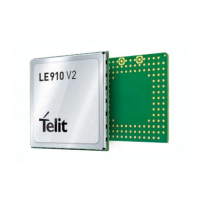Telit LE910 V2 Series AT Commands
80446ST10707A Rev. 0– 2015-11-03
Reproduction forbidden without Telit Communications S.p.A. written authorization - All Rights Reserved page 85 of 509
Mod. 0808 2011-07 Rev.2
Call deflection - +CTFR
AT+CTFR=<number>[,<type>]
Set command is used to request a service that causes an incoming
alerting call to be forwarded to a specified number. This is based
on the GSM/UMTS supplementary service CD (Call Deflection;
refer 3GPP TS 22.072).
Parameters:
<number>: string type phone number of format specified by
<type>
<type>: type of address octet in integer format; default 145 when
dialing string includes international access code character "+",
otherwise 129
Note: Call Deflection is only applicable to an incoming voice call
Test command tests for command existence
Unstructured Supplementary Service Data - +CUSD
+CUSD - Unstructured Supplementary Service Data
[<n>[,<str>
[,<dcs>]]]
Set command allows control of the Unstructured Supplementary Service Data
(USSD 3GPP TS 22.090 ).
Parameters:
<n> - is used to disable/enable the presentation of an unsolicited result code.
0 - disable the result code presentation in the DTA
1 - enable the result code presentation in the DTA
2 - cancel an ongoing USSD session (not applicable to read command
response)
<str> - USSD-string (when <str> parameter is not given, network is not
interrogated)
- If <dcs> indicates that GSM338 default alphabet is used ME/TA converts
GSM alphabet into current TE character set (see +CSCS).
- If <dcs> indicates that 8-bit data coding scheme is used: ME/TA converts
each 8-bit octet into two IRA character long hexadecimal number; e.g. octet
with integer value 42 is presented to TE as two characters 2A (IRA 50 and 65).
<dcs> - 3GPP TS 23.038 Cell Broadcast Data Coding Scheme in integer format
(default is 0).
Note: the unsolicited result code enabled by parameter <n> is in the format:
+CUSD: <m>[,<str>,<dcs>] to the TE

